SAN ANTONIO — One day after Dr. Anthony Fauci said the U.S. was no longer in a "full-blown explosive pandemic phase" in regards to the fight against COVID-19, Bexar County health officials recorded the community's largest one-day increase in virus-related hospitalizations in over a month.
There were 63 patients hospitalized in San Antonio-area facilities on Thursday, up 11 from Wednesday but still down 24% since the start of April. Of those 63 patients, 11 were in intensive care and eight were using ventilators to help them breathe.
Meanwhile, Metro Health's COVID-19 risk indicator remained at "mild" amid a recent uptick in cases. Another 132 infections were reported Thursday, making it the 11th day in the last two weeks with new-case counts in the triple-digits (no daily counts of at 100 or more were reported the first two weeks of April). The seven-day new case average stood pat at 116 Thursday.
No new virus-related deaths were recorded Thursday. At least 5,320 Bexar County residents have died from coronavirus complications, while more than 538,000 have been diagnosed.
How Bexar County is trending




Vaccine Progress in Bexar County
The following numbers are provided by San Antonio Metro Health. A full breakdown can be found here.
- 1.443 million eligible Bexar County residents are fully vaccinated as of Monday, April 18.
- More than 505,000 eligible Bexar County residents have received their COVID-19 booster shot, as of Monday, April 18.
The CDC states that "when a high percentage of the community is immune to a disease (through vaccination and/or prior illness)," that community will have reached herd immunity, "making the spread of this disease from person to person unlikely."
The City of San Antonio breaks down the vaccination rates by zip code on Metro Health's Vaccination Statistics page.
Coronavirus in Texas
The total number of coronavirus cases in the state since the pandemic began grew by 2,729 on Thursday, according to the Texas Department of State Health Services. That total includes 1,637 new confirmed cases and 1,092 new probable cases. More details can be found on this page.
Thursday's figures bring the total number of Texans diagnosed with COVID-19 to more than 6.734 million.
An additional 19 Texans have died from virus complications, meanwhile, raising the statewide death toll to 86,533.
Coronavirus symptoms
The symptoms of coronavirus can be similar to the flu or a bad cold. Symptoms include fever or chills, cough, shortness of breath or difficulty breathing, fatigue, muscle or body aches, headache, new loss of taste or smell sore throat, congestion or runny nose, nausea or vomiting, and diarrhea, according to the Centers for Disease Control.
Most healthy people will have mild symptoms. A study of more than 72,000 patients by the Centers for Disease Control in China showed 80 percent of the cases there were mild.
But infections can cause pneumonia, severe acute respiratory syndrome, kidney failure, and even death, according to the World Health Organization. Older people with underlying health conditions are most at risk.
Experts determined there was consistent evidence these conditions increase a person's risk, regardless of age:
- Chronic kidney disease
- COPD (chronic obstructive pulmonary disease)
- Obesity (BMI of 30 or higher)
- Immunocompromised state (weakened immune system) from solid organ transplant
- Serious heart conditions, such as heart failure, coronary artery disease, or cardiomyopathies
- Sickle cell disease
- Type 2 diabetes
- The CDC believes symptoms may appear anywhere from two to 14 days after being exposed.
Human coronaviruses are usually spread...
- Between people who are in close contact with one another (within about 6 feet).
- Through respiratory droplets produced when an infected person coughs, sneezes or talks. These droplets can land in the mouths or noses of people who are nearby or possibly be inhaled into the lungs.
- Some recent studies have suggested that COVID-19 may be spread by people who are not showing symptoms.
Help stop the spread of coronavirus
- Stay home when you are sick.
- Eat and sleep separately from your family members
- Use different utensils and dishes
- Cover your cough or sneeze with your arm, not your hand.
- If you use a tissue, throw it in the trash.
Find a Testing Location
City officials recommend getting a COVID-19 test if you experience fever or chills, cough, shortness of breath or difficulty breathing, fatigue, muscle or body aches, headache, new loss of taste or smell, sore throat, congestion or runny nose, nausea or vomiting, or diarrhea.
Here's a Testing Sites Locator to help you find the testing location closest to you in San Antonio.
Latest Coronavirus Headlines
- Here's when kids under 5 may start getting COVID-19 shots
- New CDC report estimates percentage of Americans with COVID antibodies
- VERIFY | It is possible that the XE COVID-19 variant found overseas is already in south Texas?
- Fauci says US entering transitionary phase of COVID pandemic
- CDC: COVID was 3rd leading cause of death in US again for 2021
- Texas gubernatorial candidate Beto O'Rourke tests positive for COVID-19
- Vice President Kamala Harris tests positive for COVID
- Pfizer asks FDA to authorize COVID booster for kids 5 to 11 years old

